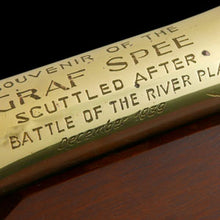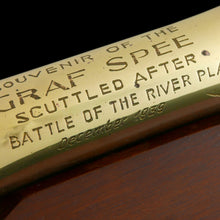Relic of the Battle of the River Plate - Graf Spee, 1940
Adding product to your cart
Length: 12.1cm (4.75in)
Brass. Heavy gauge section of tubing closed at each end and finely engraved 'Souvenir of the Graf Spee, Scuttled After The Battle Of The River Plate, December 1939’. Presented on original period mahogany stand.
The wreck of the German surface raider KMS Admiral Graf Spee was partially broken up in situ in 1942 after being scuttled in the River Plate Estuary off Montevideo, Uruguay in 1940. The salvage rights were purchased from the Nazis by a local engineering company, that was in fact a front set up by British intelligence, for the large sum of £14,000. The British had been surprised by the accuracy of Graf Spee’s gunnery and expected to find a radar range finder, which they did. They used the knowledge thus acquired to try to develop countermeasures, under the leadership of Fred Hoyle at the British radar project. The Admiralty complained about the large sum paid for the salvage rights.
Read more
The Deutschland-class Panzerschiffe Graf Spee commanded by Kapitän zur See Hans Langsdorff sank eight merchant ships between September and December 1940. Luckily Graf Spee’s fire-control radar which should have been decisive in a gun duel was put out of action early in the battle fought on 13 December allowing Commodore Henry Harwood’s cruisers HMS Exeter, Achilles and Ajax to prevail. After exchanging fire for 83 minutes on 13 December, the German ship, with casualties of some sixty dead and 30 wounded, withdrew into the neutral port of Montevideo and was scuttled. Three days later Langsdorff shot himself in a hotel room in Buenos Aires, Argentina. Victory in the Battle of the River Plate served as a major boost to British morale at a time of growing criticism of the Admiralty’s decision making and Churchill’s role as First Lord of the Admiralty.









